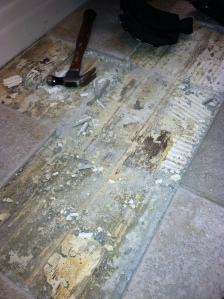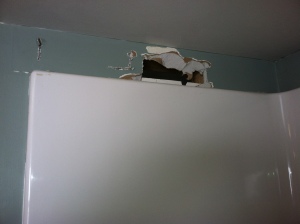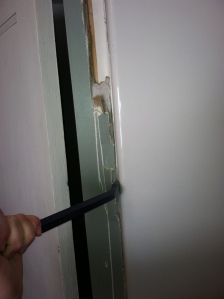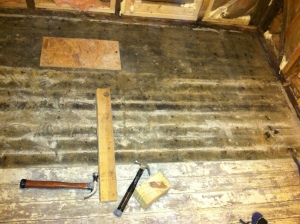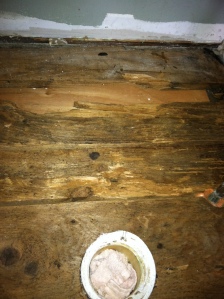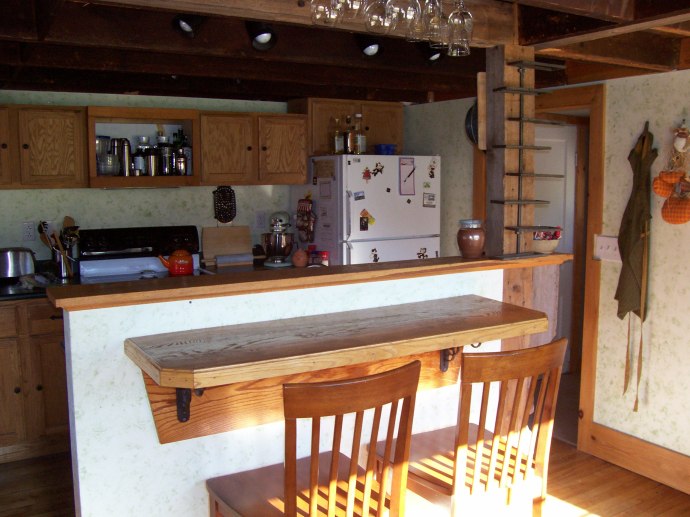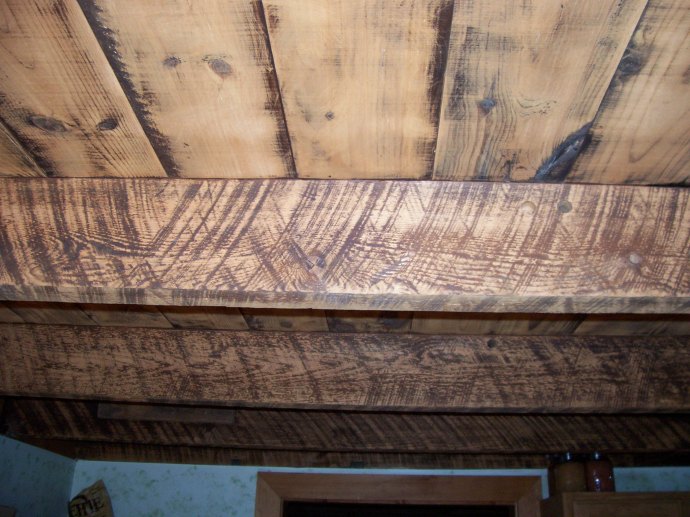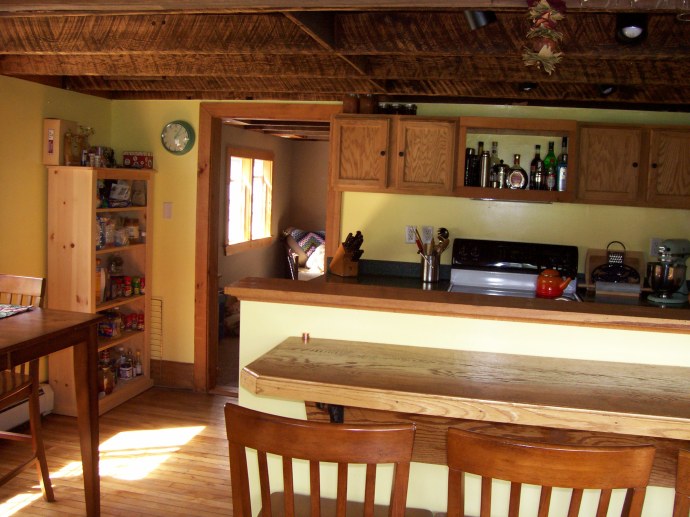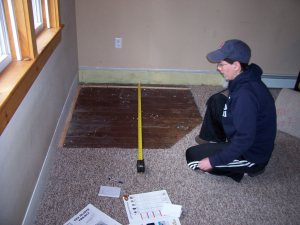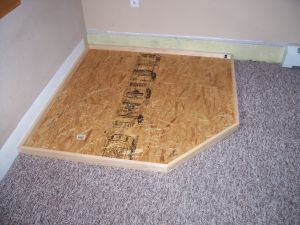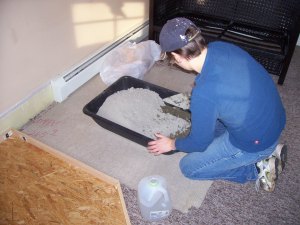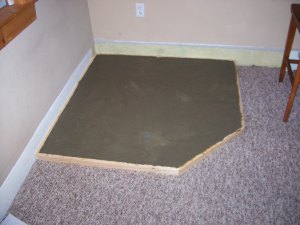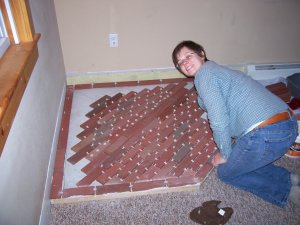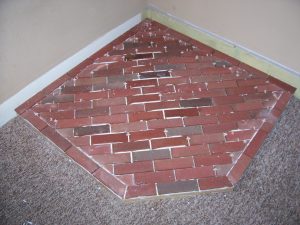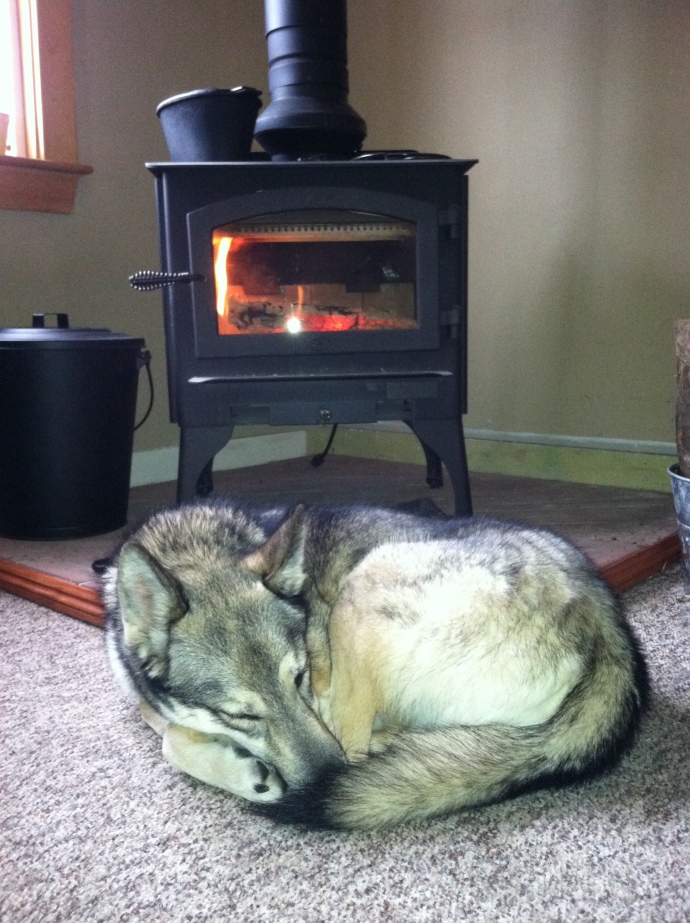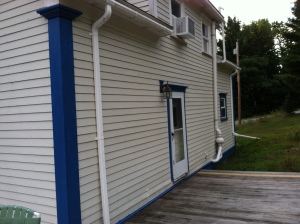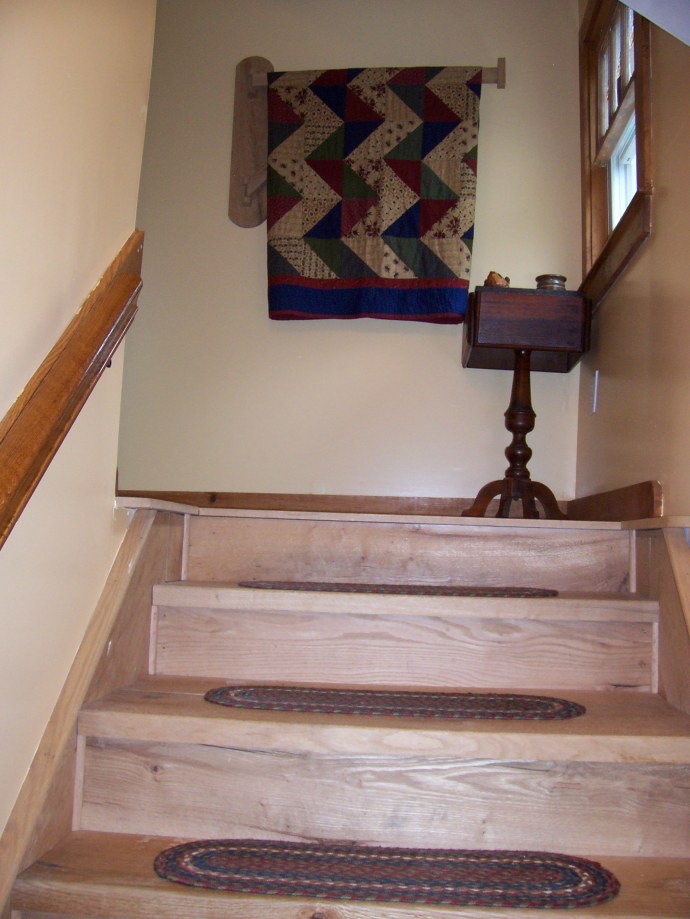“Marshmallows!” That is the first thing that popped into my mind as I rounded the corner into the living room of our soon-to-be new house. (The second thing that popped into my mind was an image of the Stay Puft Marshmallow Man from the 1984 Ghostbusters movie…this, I am sure happens to everyone in my generation after imagining a perfectly toasted marshmallow.)

I knew that the woodstove that sat in the middle of the living room floor would cause problems (most of these as stubbed toes and hip bruising), but the promise of warm fires and toasted marshmallows drew me in to love the damn thing. We were forewarned when we bought the house that the woodstove was not up to code and should not be used until a proper venting system was created for it. The thimble to the woodstove was attached to vent out of the chimney that ran through the center of the house. This would not normally be an issue, except that the same chimney (our only chimney) was also the vent for our oil burning furnace. While it might be ok to run two or more thimbles into a single flue chimney, mixing the exhaust of different combustion materials is a major no no. Thus, our hell begins.
The first winter we spent in our house was a doozie. It was cold, windy, and we had more snow than we had piles to shovel it on. We had spent everything we had on the house inspection and other necessary things we had needed (snowblower not included), so when the winter came around, we grabbed two shovels and hoped for the best. Every week we would have a foot or more of snow dropped on our driveway. The first few times our neighbors helped out by plowing our driveway or swinging over with their snowblower – we were eternally grateful, because there is nothing worse than coming home after work to find 3 feet of snow in the driveway and no where to park your car on the dark, icy, country road. We would spend hours shoveling and when we came in we were wet, cold, and tired.
Although a fire would have been the perfect end to an evening of shoveling, our woodstove was cold and empty. It had become a very large and heavy shelf for our things. It dried mittens, it held trinkets, and it even supported our Christmas tree for a few weeks. We had every intention on reventing the flue, but didn’t have the funds to support it yet. In the mean time, we were burning nearly 100 gallons of fuel oil every three weeks. Now, for those of you who know me well, you know I am a bit of an eco nerd. The fact that I was burning that much oil disgusted me…but that was only second on my mind behind oil being $3.65 a gallon and climbing.
The straw that finally broke my back happened in March when Sarah was in Florida. We had just adopted a new dog (Chloe), and I was attempting to train her. A massive snow storm barreled through the area and dropped a foot or more of snow. I am forced to leave both dogs in the house while I spend four hours trying to shovel enough driveway space to get our car off of the road. I come back in to say hi to our untrained dog, only to find her on top of the kitchen table, excrement everywhere. Could it get worse? The power goes out. The house slowly cools off throughout the night, but when the power returns, the heat does not. I smell smoke. The furnace motor is dead. So now I am cold, worried about the pipes freezing, wondering what to do with the dogs (because it’s too cold to leave them home), and I have to go to work. Must have been nice in Florida. Thankfully, I was able to get the furnace fixed that day…but I have been an avid pusher for a new chimney ever since. Sarah, not actually having been home over those two days needed more convincing.
The weather warmed up and summer came. I kept pushing her to help me find a mason who would build a new chimney for our woodstove before winter fell again. We found a mason, but decided to wait until we had enough money saved to build a chimney without a loan. In August, hurricane Irene hit. We lost power for over a week. Lucky for us, working at a college has its perks. We were able to shower at the gym and had access to water. Food was a different story. We had to eat out for a week, as there was no way to cook the food we had. Even in August when it was warm, a hot pot of water is priceless. This was my bargaining chip. “Sarah, I know that we had said we would save for a chimney first, but if I got a loan for it, could we build it now? What will we do if we loose power for over a week in the middle of winter?”
We started the process in September. We contacted our mason, who said he would start building the foundation. We began to clean the woodstove. When we were finally able to pry the doors open, we found 3 inches of ash. We shop-vac it until it was pristine. We noticed there were a few pieces that were cracked, warped, and melted, so we took pictures of the pieces and went to the local fireplace shop to order replacements. It was then that we learned that the “newly installed woodstove” was “newly installed”, but not a new woodstove. Our woodstove was 25 years old. We also learned that day that woodstoves don’t last a lifetime…they last 10-20 years or so. So, we went shopping for a new woodstove.
By now it was the third week of October with no word from our mason. We called to see when he might start digging the foundation – after all, the ground was starting to freeze. A week goes by, and without a call, he shows up, digs the foundation, pours the cement, and allows it to dry. Two weeks go by without a word. We call him, he says he’ll be there that weekend to start building it up. No show. We call again. He’ll be there sometime this week. He shows up on Friday, works for two hours, leaves. Three weeks go by, it is now mid December and our chimney is only 4 feet tall. We call him again, he’ll be there that weekend. No show. It isn’t until 2 days before Sarah and I are going to travel for Christmas break does he show up again. He rips a massive hole in the side of our house for the thimble. Throws a thimble in it, patches it up shoddy, sticks some newspaper in it and calls it good. We wrap the thimble, clean up his mess (because he was too busy to do it), and get ready for our trip. He comes by the next day (yes, two days in a row, a miracle!) and hooks up our stove. It looks terrible. We decide it needs to be redone by someone else, so we call our local fireplace shop and make an appointment for the new year.
While on our vacation, I get a missed call and a message on my phone. Our chimney is done, we can burn in it. We drive home, look at our chimney, and we both get a sick feeling in our stomachs…it just doesn’t look right. The woodstove installer comes the next day, removes his work, and precedes to tell us that he will not hook up our stove until we get our chimney inspected – he already sees several codes that have been broken. Not to mention, you need a license to hook up a woodstove, which our mason did illegally. Thankfully we were smart enough to NOT burn in our stove, as there is a good chance we could have set our house on fire and our insurance would not have covered us for it.
We hired a chimney inspector. He laughed at this mason’s work and gave us all of the codes that he broke. Simple things, like:
1. Make sure the chimney is tall enough, make sure that it surpasses the crest of your roof. Duh. This can set your roof on fire.

2. Make sure that all of the mortar on the inside of the chimney flue is wiped clean, or else it will cause turbulence and creosote will build up. This will start a chimney fire.

3. You need 18 inches of non-combustible material between the thimble and a combustible material. Otherwise, you can start a wall fire.
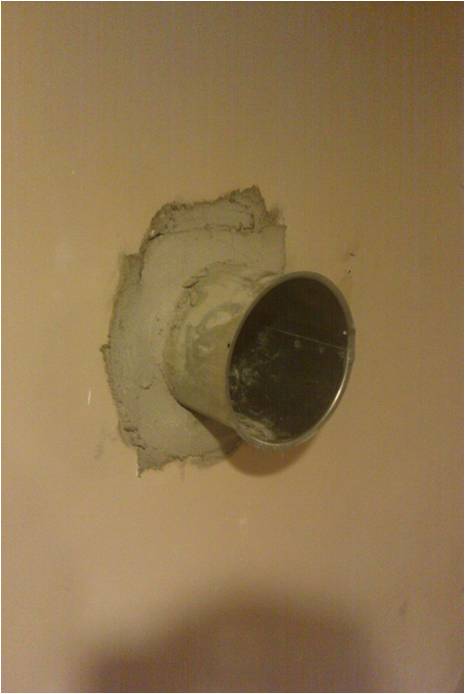

4. Your thimble can not protrude inside your chimney flue, it must remain flush to the flue. Otherwise, a chimney sweep can not clean it, and it can start a chimney fire. If it is WAY too far into the flue, the hot air will back up into the thimble, creating an unsafe situation in the woodstove and the woodstove flue.

5. EVERY flue must have a clean out door.
Our chimney was deemed unsafe, and was to be taken offline (luckily, it was never put online). We called our mason. He argued with us, telling us that our chimney inspector was wrong and didn’t know what he was talking about…after all, he had been building chimneys for years. But, we withheld his payment until our chimney passed code, so he promised to fix his mistakes. He would do it in the spring, since it was too cold for him in January.
Lucky for us, we had a very mild winter this year. We didn’t loose electricity a lot, and when we did, it was never for long. Snow was not an issue this year, and we finally could afford to buy ourselves a snowblower for Christmas. We has long stretches of temperatures in the 60’s and 70’s in February, and although we and our neighbors spent time outdoors getting things done, our mason could not be reached. It wasn’t until April that we hounded him – leaving messages on his 5 different phone numbers every day. It wasn’t until we threatened to take him to court that he finally called us back. He told us that he wouldn’t touch our chimney until he received payment from us. We, seeing the work he had done, refused to pay him until he could provide us with a chimney that passed code. He told us that our chimney inspector was full of shit, and that it was the fire marshal that passed chimneys, not the chimney inspectors.
The next day, I called the state fire marshal. I told him our situation, and relayed the inspection report to him. I learned that the state fire marshal does not inspect chimneys, that is what the chimney inspectors are for. He assured me that my inspector did everything right, and I should listen to him. He gave me the website to the attorney general’s page, and told me to contact their consumer protection division and to follow through with their process. If it came to court, the state would be behind us.
I followed the directions from the attorney generals page. Before a mediation can begin, they recommended sending a formal letter to the mason, detailing dates, payments, and issues, as well as your demands. The letter must be sent priority, and you should have the letter signed on delivery so you can prove that it was received. I had been keeping phone conversations, emails, receipts, and dates, so it was an easy (albeit, infuriating) letter to compose. We told him to have the chimney brought up to code by May 31st. On May 28th, a new mason shows up. This mason, new to us, was hired by our old mason. We were not notified of this mason switch, we were not asked if it were ok, and we were not told that he was going to be working on our house that day when we weren’t home. All of that aside, he did decent work, was polite, and actually showed up for a week straight, working on the chimney until it was fixed.
We had the inspector come back a second time. He said the chimney was good stave for one thing, the thimble in the basement flue was still only 6 inches from a combustible surface. To get the 18 inches needed, they would have had to drop the thimble that much lower (which we found impossible due to the placement of the chimney foundation), or replace the current flue with an insulated one. We mentioned this to our new mason, who proceeded to chew us out telling us that we don’t know what we are talking about and that our chimney inspector doesn’t pass our chimney, the local code enforcer does…go figure. (By the way…the local code enforcer reports to the state, who refers you to the state fire marshal, who refers you back to the chimney inspector.) Three weeks later, the new mason comes by the house (unexpectedly, of course) and disrupts our dinner with guests. We have to go downstairs and let him into the basement to pop in the adaptor. This adaptor attaches to the end of the flue so that you can hook an insulated pipe to it, but doesn’t make the thimble insulated itself. We call the inspector, no good.
Our old mason calls…”where’s my money?” We tell him that the downstairs thimble is still incorrect. We tell him which one to buy. Two weeks later (now into July), he randomly drops by. He brings the piece. I take the piece number upstairs, call the inspector and tell him what it is. It’s the wrong one. I tell our mason to stop working, buy the right one and come back by the end of the week. He does. We check it over. We approve. We pay him and send him off with a big “fuck you” as he drives off our property for the absolute last time.
So, what did we learn?
1. When someone says that something is “newly installed”, it doesn’t mean that it’s new.
2. Build your own chimney, because you can’t trust anyone more than you can trust yourself.
3. If you must hire a chimney mason, ask them to see their NFPA-211 (it’s the code book). If they know what they are doing, it will be with them. If they actually use it for their jobs, it better not look brand new.
4. When you hire someone to do the work (mason, carpenter, plumber, electrician…), do your research, know the codes, watch them constantly, and question everything. If you let them do what they want without question, the only one you are screwing is yourself.
5. Sometimes the “three times longer” rule doesn’t apply, sometimes the project will take 6 months longer to complete.
In a few short weeks our stove will be up and running. Let’s hope that it was worth it.




